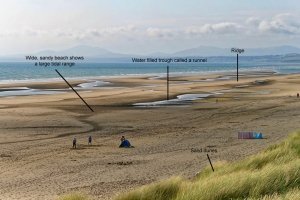Landforms of Coastal Deposition Flashcards
What is a sand dune?
Click to View the Answer
Click to View the Question
A sand dune is a small ridge or hill of sand found at the top of a beach, above the reach of the waves.
Find out more about sand dunes.
What is a sand dune?
Identify 3 landforms of coastal deposition.
Click to View the Answer
Click to View the Question
Beaches, sand dunes, spits and bars.
Find out more about landforms of coastal deposition.
Identify 3 landforms of coastal deposition.
How are off-shore bars formed?
Click to View the Answer
Click to View the Question
Offshore bars form when sediment is transported on and off a beach. Destructive waves remove sediment from the beach and form the offshore bar.
Find out more about landforms of coastal deposition.
How are off-shore bars formed?
Where do sandy beaches typically form?
Click to View the Answer
Click to View the Question
A sandy beach is usually formed in a sheltered bays, where low energy, constructive waves transport material onto the shore.
Find out more about landforms of coastal deposition.
Where do sandy beaches typically form?
What are ridges and runnels?
Click to View the Answer
Click to View the Question
Ridges are areas of the beach that are raised. The dips are water-filled troughs called runnels.
Find out more about landforms of coastal deposition.
What are ridges and runnels?

